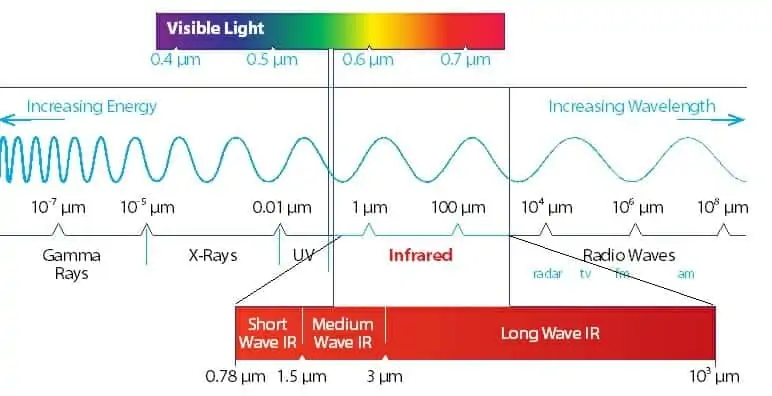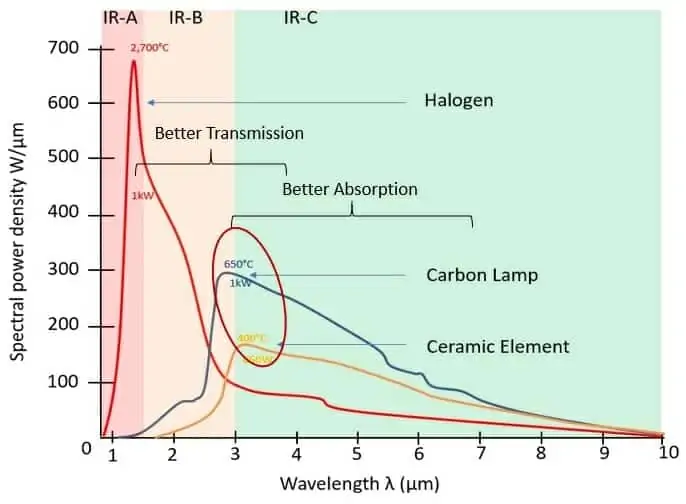
3 Types of Infrared heat
Infrared is a form of energy forming part of the electromagnetic spectrum after the colour red.
Infrared is a heat-producing wavelength from 0.78 microns to 1000 microns (or 1 millimetre) and covers a thermal range of several thousand degrees centigrade down to absolute zero.
Any object with a temperature greater than 0°K will radiate infrared energy.
Because of the huge temperature range covered by Infrared and the different physical characteristics of the heat as you progress through the frequencies, infrared itself has been divided into three different types of Infrared:
- Short Wave (Or Near Infrared, or IR-A). 0.78 to 1.5 microns: covers the thousands to high hundreds of degrees Centigrade.
- Medium Wave (Or Medium or Middle Infrared, or IR-B). 1.5 to 3 microns: covers the high hundreds to mid-hundreds of degrees Centigrade.
- Longwave Infrared (Or Far Infrared, or IR-C). 3 microns to 1000 microns (1mm): covers the mid hundreds of degrees centigrade to absolute zero.
Because all these three types are heat producing and have different characteristics, it is important to know what sort of infrared we can use for heating situations and how to apply it.
Transmission Vs Absorption
The shorter the IR wavelength, the “hotter” the IR heater is and the more “transmissive” its heat is, meaning it can travel greater distances in narrower “beams”.
For comfort heating, this can be useful for immediate “boost” or overcoming long distances or higher airflow – and this is the key distinction about this type of IR heater. The heat is very “transmissive” and is best suited for covering large distances or overcoming draughts. These heaters emit lower wattage in the wavelengths humans absorb so well (which are 3 microns and below). See the very sharp red curve in the graph in the shorter wavelengths and the relatively poor wattage output in the longer wavelengths. Most of the energy used by these heaters is in the projection of the heat (the “throw”) and less of it is used for actual human comfort. Short wave infrared is distinctive for its very bright light as well as its strong heat.
As you move towards the right of the graph, the physical characteristics of the heat change from “more transmissive” more “better absorbed” and the strong light gradually changes into a red glow.

Around the transition point between IR-B and IR-C (marked by the red oval shape on the graph) is the “Draper” point. This is around 525°C and it is the point most objects being to emit visible light and is no coincidence therefore it also marks the change from medium infrared (that glows) to Far infrared (which emits no light at all).
This area marked by the red oval shape is the waveband where (for people) objects are at their best mixture of transmissiveness and absorbency and is really the “sweet spot” – the most effective region for Heating people effectively in large spaces.
Think about sitting around a camp fire – which is emitting at exactly these wavelengths. Go a bit hotter (to the left of the chart) and you can get more distance out of the heater, or overcome a bit more airflow but the heat itself is not so comfortable. Go a bit cooler (towards the right of the chart), you can get closer and feel more generally and thoroughly warmed. Think in these terms for space heating too.
As you proceed further to the right, around 5 – 8 microns, the application of the type of infrared changes from a space heating role, to a gentler heating more suitable for enclosed areas like domestic rooms and offices and there is no light emitted from the infrared heater. 5-8 microns are the peak wavelengths of the Far Infrared panel heaters produced by Herschel.
Human beings – having a body temperature of 37°C – are also radiant objects. 37°C is 9 microns, so it stands to reason that heaters that output at or below 9 microns or 37°C are not “radiating” to humans at all. They may have some beneficial effect of warming air and slowing down our sense of heat loss, but it is impossible we can perceive their heat output as “radiant” if they are cooler than our own bodies.
Types of Infrared Heater from Herschel
Herschel Infrared supplies
Far Infrared Panels – these are mostly used in residential and office applications.
Far Infrared Space Heaters – for heating larger enclosed spaces
Medium Infrared Space Heaters – for heating unsheltered areas (e.g. patios).
